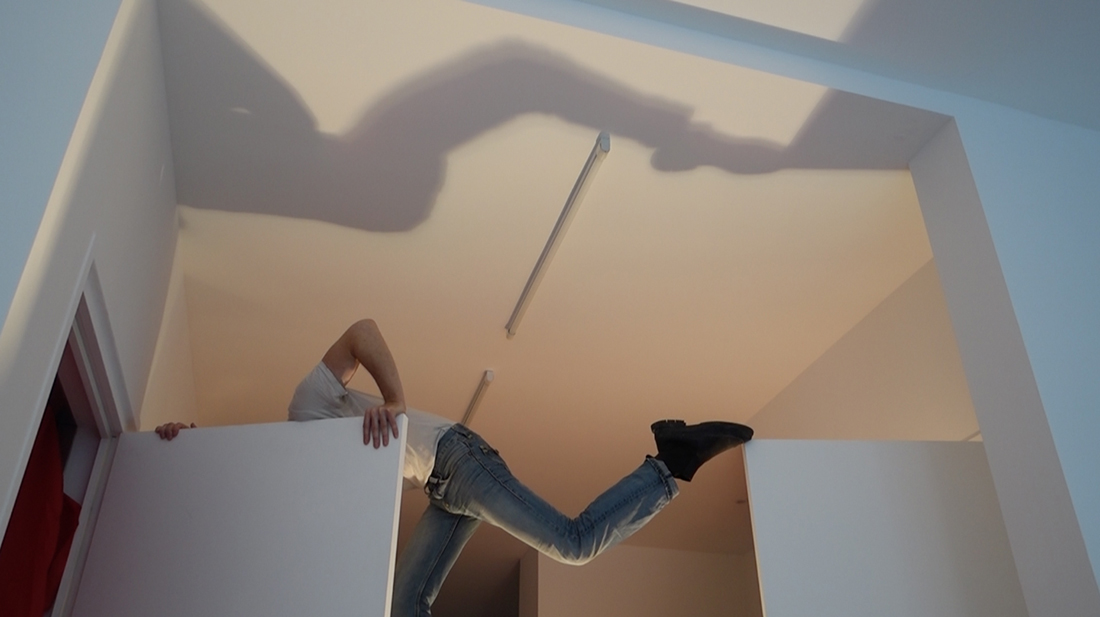Assisted Manifesto
Exhibition
From 11 February to 29 May 2023
Curator: Marie Cozette
The artist write about his exhibition at Crac Occitanie:
“Close actions” were first carried out during visits with my father, Philippe Fouché, at the medical institutions in which he has been living since 2015 (hospitals, a rehabilitation facility, a nursing home…) following a stroke that paralysed him on one side. Through gestures, displacements and manipulations of objects found on site, I intensified my relationship with spaces arranged for care, which had
become places of a family life. I acted in Philippe’s vicinity, rather than with him, during waiting times when health professionals were caring for him.
“Close actions” is derived from “close presences”, the expression by which Fernand Deligny designated the non-professionals who, in the middle of the Cévennes from 1967 to the 1990s, watched over autistic children entrusted to them, inventing a way of life with them outside of any institutional framework, on experimental camps dubbed “living areas”.


Florian Fouché received aid from the Drac Île-de-France for this exhibition (Aide
individuelle à la création 2022).
He received the kind permission of Xavier Rey, director of the Musée National d’Art Moderne, and Laurent Le Bon, president of the Centre Pompidou, to create the film Vie institutionnelle [Institutional Life] in the reconstructed studio of Constantin Brâncuși .
Florian Fouché was supported by the Fondation OVE, which made spaces available for an experiment at the Centre Robert Doisneau (Paris). The participation of several people receiving care on those sites was made possible by the voices of Natacha Berger and Laëtitia Le Sénéchal.
Some works presented in the exhibition were produced with support from
Bétonsalon (Paris).

Top page photo: Exhibition view of « Assisted Manifesto » by Florian Fouché, Crac Occitanie -Sète, 2023. Théâtre du soin, la destruction du service de santé publique, (détail) 2023 © of the artist and courtesy galerie Parliament, Paris. Photo : Aurélien Mole.
Picture in the text: Florian Fouché, film still of the video Mémoire aberrante (roman cubiste de la Tentative), in the Manifeste assisté series, 2022 - © of the artist and courtesy galerie Parliament, Paris.

Vue de l’exposition « Manifeste assisté » de Florian Fouché, Crac Occitanie -Sète, 2023. Théâtre du soin, la destruction du service de santé publique, (détail) 2023 © de l’artiste et courtesy galerie Parliament, Paris. Photo : Aurélien Mole.
«We are all assisted and assistants at the same time.
Everyone, whether powerful or powerless.»
Exhibiting Artist

Vue de l’exposition « Manifeste assisté » de Florian Fouché, Crac Occitanie -Sète, 2023. Projection de "Vie institutionnelle", 2022 © de l’artiste et courtesy galerie Parliament, Paris. Photo : Aurélien Mole.


Vue de l’exposition « Manifeste assisté » de Florian Fouché, Crac Occitanie -Sète, 2023. "Kid A", 2022. © de l’artiste et courtesy galerie Parliament, Paris. Photo Aurélien Mole.

Vue de l’exposition « Manifeste assisté » de Florian Fouché, Crac Occitanie -Sète, 2023. Au premier plan : "La vaisssssssellllllle" (2021), au fond : "Le repas des résident.es (O.R.P.H.E.A.)" (2023), "Le repas des résident.es (suicide d’une soignante)" (2023), "La vaissssssellllllle de Kid A [soleil vert]" (2023) © de l’artiste et courtesy galerie Parliament, Paris. Photo Aurélien Mole.

Vue de l’exposition « Manifeste assisté » de Florian Fouché, Crac Occitanie -Sète, 2023. "Le repas des résident.es (O.R.P.H.E.A.)" (2023), "Le repas des résident.es (suicide d’une soignante)" (2023), "La vaissssssellllllle de Kid A [soleil vert]" (2023) © de l’artiste et courtesy galerie Parliament, Paris. Photo Aurélien Mole.


Vue de l’exposition « Manifeste assisté » de Florian Fouché, Crac Occitanie -Sète, 2023. "La verticalisatrice [Barnett Newman]", 2020-2023. © de l’artiste et courtesy galerie Parliament, Paris. Photo : Aurélien Mole.

Vue de l’exposition « Manifeste assisté » de Florian Fouché, Crac Occitanie -Sète, 2023. Au premier plan "Assistance", 2023, chaises, fauteuils de bureaux à roulettes. Projection de "Vie institutionnelle", 2022 © de l’artiste et courtesy galerie Parliament, Paris. Photo : Aurélien Mole.
 + 14 autres photos
+ 14 autres photos
Vue de l’exposition « Manifeste assisté » de Florian Fouché, Crac Occitanie -Sète, 2023. "Théâtre du soin, la destruction du service de santé publique", 2023 © de l’artiste et courtesy galerie Parliament, Paris. Photo : Aurélien Mole.


























































